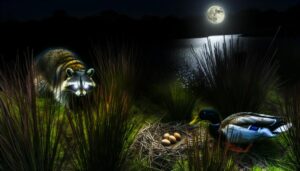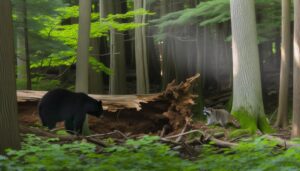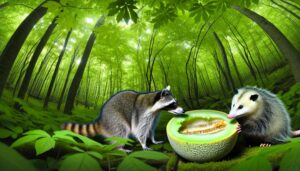How Do Raccoons Eat Fish in Your Pond and How to Prevent It?
Yes, raccoons do eat fish in ponds. Raccoons are omnivorous, employing tactile foraging to hunt various prey, including fish.
Their nocturnal habits make pond fish particularly vulnerable. Raccoons use their highly sensitive hands to detect and catch fish quickly and quietly.
Signs of raccoon activity around ponds include disturbed vegetation, overturned rocks, and tracks with distinctive long, slender toes. Scat containing fish scales also indicates predation.
Physical barriers, habitat modifications, and repellents can mitigate their impact on pond ecosystems. Effective management involves understanding these behaviors and implementing strategies to protect your pond.
Exploring more can provide additional insights into these methods.

Key Takeaways
- Raccoons are nocturnal predators that often hunt pond fish.
- They use tactile sensitivity to locate and capture fish in ponds.
- Physical barriers like pond netting can help prevent raccoon predation.
- Disturbed vegetation and overturned rocks are signs of raccoon activity near ponds.
- Raccoons' predation on pond fish can influence the pond's ecological balance.
Raccoon Diet Overview
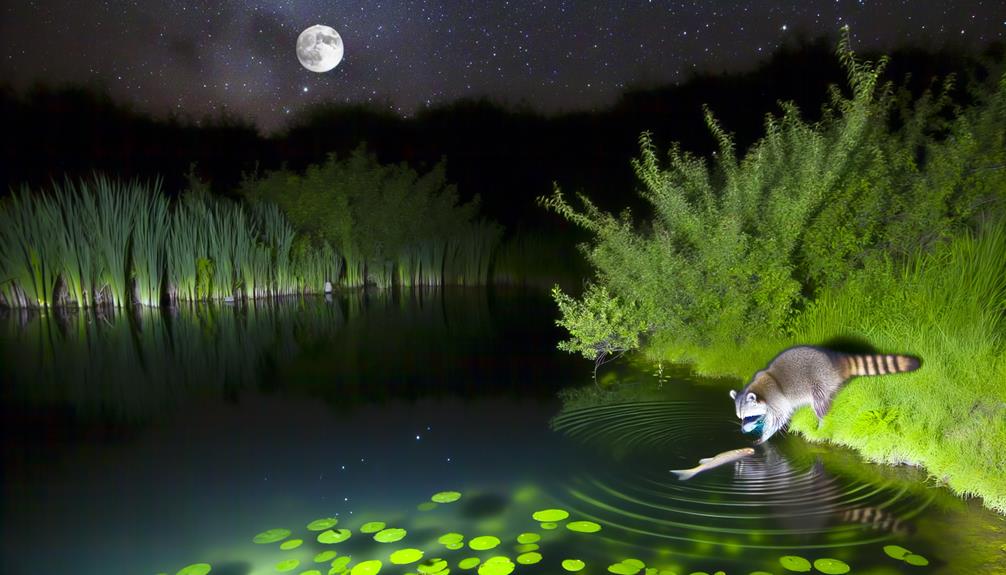
Raccoons (Procyon lotor) exhibit an omnivorous diet, consuming a diverse array of foods such as fruits, nuts, insects, small mammals, and aquatic organisms. This dietary flexibility allows raccoons to thrive in various environments, from urban areas to dense forests.
Seasonal changes influence their food preferences; for instance, they consume more plant-based foods like berries and nuts in the summer and fall to build fat reserves for winter. Aquatic organisms, including fish, form an important part of their diet, particularly in regions with abundant water sources.
This broad diet not only supports their nutritional needs but also demonstrates their adaptability. Understanding their dietary habits is essential for comprehending their ecological role and potential impacts on local ecosystems.
Hunting Behavior
Raccoons exhibit notable hunting behaviors characterized by their nocturnal feeding patterns and strategic approach. These animals primarily hunt during the night, using the cover of darkness to enhance their stealth.
Their methodical strategies involve a combination of tactile sensitivity and opportunistic tactics to capture fish and other prey in pond environments.
Nocturnal Feeding Patterns
During the night, raccoons exhibit highly adapted hunting behaviors, leveraging their acute senses to locate and capture fish in pond environments. These nocturnal mammals employ a combination of tactile sensitivity and auditory acuity to detect prey in low-light conditions. Their forepaws, equipped with highly sensitive touch receptors, allow them to feel for fish beneath the water's surface. Additionally, raccoons are known for their exceptional night vision and keen hearing, which further aid in their hunting endeavors.
These traits make raccoons proficient nocturnal hunters in pond ecosystems.
- Tactile Sensitivity: Highly sensitive forepaws for detecting prey.
- Auditory Acuity: Exceptional hearing to locate fish movements.
- Night Vision: Superior vision for hunting in low-light conditions.
- Adaptability: Ability to hunt effectively in various aquatic environments.
Stealth and Strategy
Exploiting their natural cunning, raccoons employ a variety of stealthy tactics and strategic maneuvers to maximize their hunting success in pond environments. These nocturnal mammals take advantage of low-light conditions to approach their prey undetected, utilizing their acute sense of touch and hearing to locate fish.
They often wade slowly through the shallow waters, minimizing ripples and disturbances that might alert potential prey. Additionally, raccoons use their dexterous front paws to feel for fish under rocks and submerged vegetation, a behavior known as 'dipping.' This tactile hunting method allows them to capture fish with precision.
Such strategies demonstrate raccoons' adaptability and resourcefulness, key factors that contribute to their effective predation in aquatic ecosystems.
Pond Fish as Prey
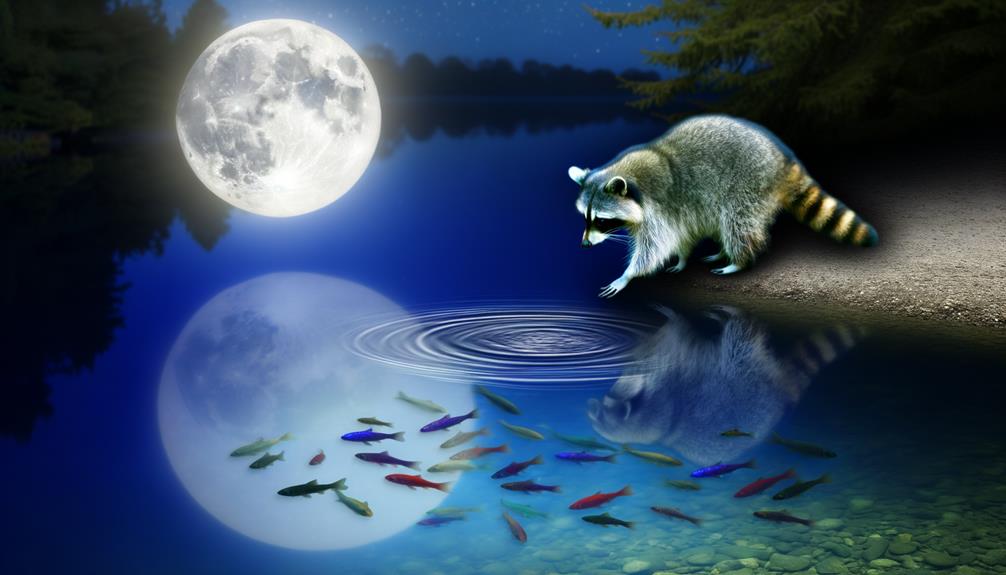
Raccoons exhibit specific hunting behaviors that make pond fish particularly susceptible to predation, focusing on their nocturnal activities and tactile foraging techniques.
Factors such as fish size, pond depth, and vegetation density notably influence the vulnerability of pond fish to raccoon predation.
Consequently, various preventive measures, including physical barriers and habitat modifications, are often implemented to mitigate the impact on pond fish populations.
Raccoon Hunting Behavior
Raccoon hunting behavior exhibits remarkable adaptability and opportunism, particularly when targeting fish in pond environments. These nocturnal mammals exploit their keen sense of touch and dexterous forepaws to locate and capture prey under water.
Their foraging strategy is characterized by several distinct behaviors:
- Tactile Exploration: Raccoons use their highly sensitive paws to feel for fish in murky waters.
- Stealth and Patience: They often remain motionless at the water's edge, waiting for the right moment to strike.
- Diverse Diet: While opportunistic, fish can constitute a significant portion of their diet when available.
- Seasonal Variability: Hunting patterns may vary with the seasons, adapting to the availability of aquatic resources.
This behavioral adaptability underscores the raccoon's effectiveness as a predator in pond ecosystems.
Fish Vulnerability Factors
Understanding the factors that make pond fish vulnerable to predation is critical in evaluating the impact of raccoon hunting behavior on aquatic ecosystems. Various elements contribute to the susceptibility of fish to such predation. Key factors include the size and species of the fish, the depth and clarity of the pond, and the availability of hiding spots. Smaller fish are easier for raccoons to capture, while murky waters can offer some protection. Additionally, ponds with abundant vegetation provide shelter, reducing predation risk.
| Factor | Impact on Vulnerability |
|---|---|
| Fish Size | Smaller fish are more vulnerable |
| Pond Depth | Shallower ponds increase risk |
| Water Clarity | Murky water decreases visibility |
| Hiding Spots | Vegetation provides protection |
These factors collectively shape the ecological dynamics of pond environments.
Preventive Measures Taken
To mitigate the predation of pond fish by raccoons, several strategic preventive measures can be implemented, each tailored to address specific vulnerabilities within the aquatic environment. Ensuring the protection of pond fish requires a multifaceted approach that integrates physical barriers, environmental modifications, and deterrents.
Key strategies include:
- Fencing: Install a secure fence around the pond to physically prevent raccoons from accessing the area.
- Netting: Use pond netting or mesh covers to create a barrier above the water surface, reducing raccoons' ability to reach the fish.
- Habitat Modification: Design the pond with steep sides, reducing shallow areas where raccoons can easily hunt.
- Lighting: Incorporate motion-activated lights around the pond perimeter to deter nocturnal predation by startling raccoons.
Signs of Raccoon Activity
Evidence of raccoon activity around ponds can be discerned through various indicators such as disturbed vegetation, overturned rocks, and scat deposits.
Disturbed vegetation, including trampled plants and broken stems, often indicates raccoon foraging behavior.
Overturned rocks and stones are another sign, as raccoons frequently search beneath them for aquatic organisms.
Additionally, raccoon scat, identifiable by its tubular shape and often containing remnants of fish scales or crayfish shells, serves as a direct sign of their presence.
Tracks in the mud or soft soil around the pond, characterized by five long, slender toes, also provide concrete evidence.
Observing these signs can assist in confirming raccoon activity, critical for understanding their impact on pond ecosystems.
Preventative Measures
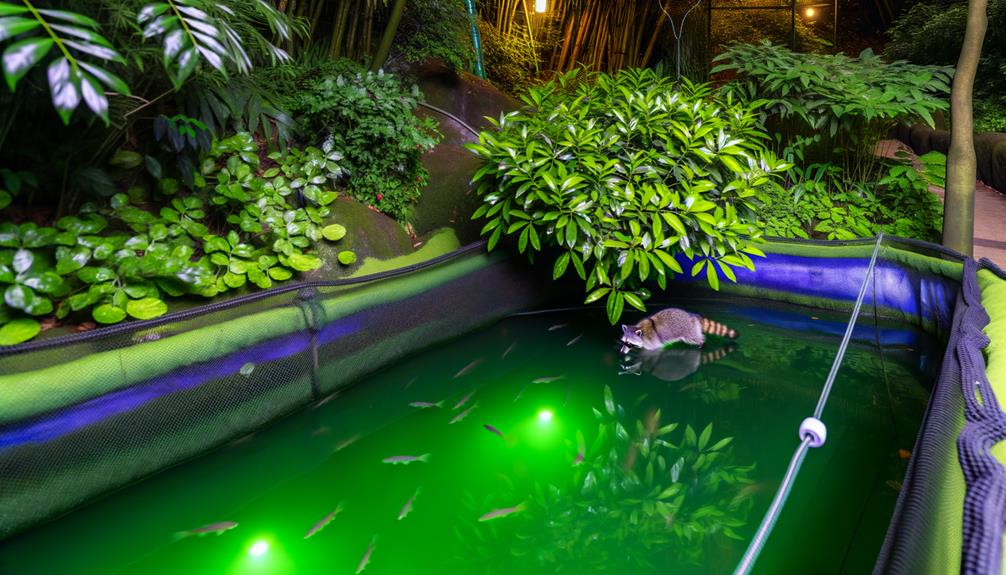
Implementing effective preventative measures is paramount once raccoon activity has been confirmed around a pond, as these methods can lessen potential ecological damage. Employing a multifaceted approach increases the likelihood of protecting fish and maintaining pond health.
Key strategies include:
- Physical Barriers: Installing fencing or netting around the pond perimeter deters raccoons from accessing the water.
- Habitat Modification: Reducing nearby food sources and cover, such as dense vegetation, decreases the attractiveness of the area to raccoons.
- Motion-Activated Devices: Utilizing lights or sprinklers triggered by movement can effectively startle and discourage raccoons.
- Chemical Repellents: Applying non-toxic, raccoon-specific repellents around the pond can create an unpleasant environment for the animals.
Implementing these measures can lessen the risk of raccoon predation on pond fish.
Coexisting With Raccoons
Successfully coexisting with raccoons around a pond involves understanding their behavior, ecological role, and implementing non-lethal management strategies that balance wildlife presence with minimal disruption to the pond ecosystem. Raccoons are nocturnal omnivores with a diet that includes fish, amphibians, and invertebrates, contributing to the ecological balance.
| Strategy | Description |
|---|---|
| Habitat Modification | Remove food sources and secure garbage to deter raccoons. |
| Physical Barriers | Install fences or pond netting to prevent raccoon access. |
| Repellents | Use motion-activated sprinklers or lights to discourage raccoons. |
| Wildlife-Friendly Design | Create hiding spots for fish and diversify vegetation to provide natural cover. |
Implementing these strategies aids in maintaining a harmonious environment, ensuring both raccoon welfare and pond ecosystem integrity.
Wildlife Impact on Ponds
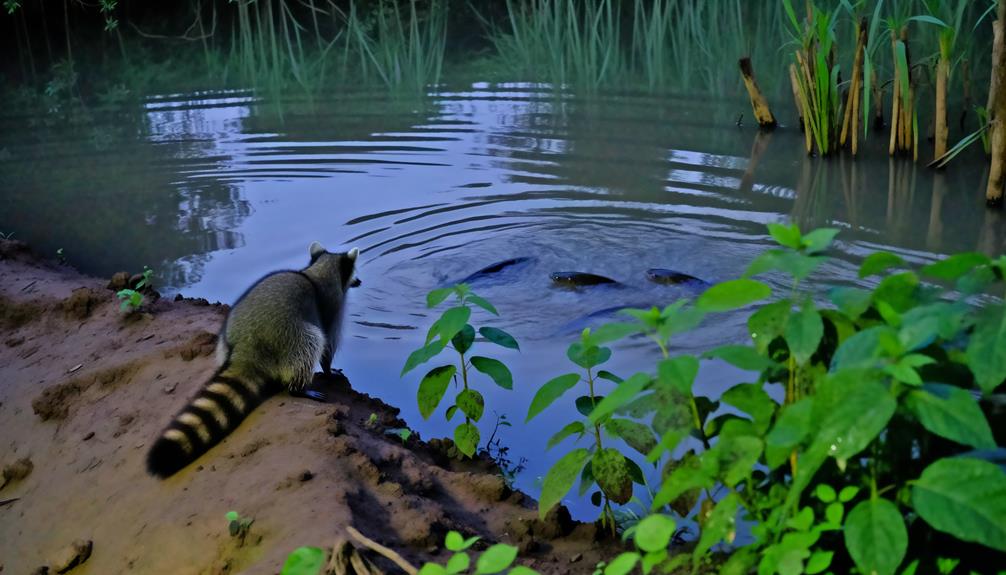
Understanding the broader impact of wildlife on pond ecosystems is critical for managing biodiversity and maintaining ecological balance. Wildlife, including raccoons, birds, amphibians, and insects, play integral roles in shaping these aquatic environments. They contribute to nutrient cycling, predation, and habitat modification, which collectively influence pond health and stability.
Nutrient Cycling:
Wildlife excretion and decomposition contribute essential nutrients to the water.
Predation:
Species such as raccoons control fish and invertebrate populations, preventing overpopulation.
Habitat Modification:
Animals like beavers can drastically alter pond landscapes, affecting water flow and vegetation.
Biodiversity Enhancement:
The presence of various wildlife species promotes a balanced ecosystem by supporting multiple trophic levels.
Recognizing these interactions is paramount for effective pond management.
Conclusion
To sum up, raccoons are opportunistic feeders with a diverse diet that includes pond fish. Studies indicate that raccoons can consume up to 40% of their diet from aquatic sources. Signs of raccoon activity, such as tracks and disturbed vegetation, can help identify their presence near ponds.
Implementing preventative measures can reduce the impact on pond ecosystems. Understanding raccoon behavior is essential for developing strategies to coexist with these adaptable mammals while preserving aquatic biodiversity.


